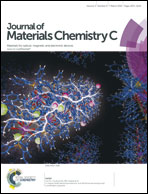Phase transition and piezoelectricity of sol–gel-processed Sm-doped BiFeO3 thin films on Pt(111)/Ti/SiO2/Si substrates†
Abstract
Bi1−xSmxFeO3 thin films (x = 0, 0.05, 0.10 and 0.15) on Pt(111)/Ti/SiO2/Si substrates were fabricated by the sol–gel process and the effect of Sm doping on their crystal structure was studied by synchrotron radiation X-ray diffraction and Raman spectroscopy. It is revealed that a phase transition from the rhombohedral to orthorhombic structure takes place with increasing Sm content, resulting in two-phase coexistence at x = 0.10, where the two phases are R3c and Pbam according to the refinement result. The phase transition can be ascribed to the difference between the smaller radius of substituted Sm3+ and Bi3+. Meanwhile, the composition-dependent dielectric, ferroelectric and piezoelectric properties were also investigated. PFM scanning and switching spectroscopy results confirmed the enhancement of the piezoresponse at x = 0.10 corresponding to the rhombohedral–orthorhombic morphotropic phase boundary (MPB) region. The ferroelectric properties of Sm-doped BiFeO3 films were found to decrease with increasing Sm content, indicating that the extrinsic piezoelectric response contributes more to the improved piezoelectricity at the MPB.


 Please wait while we load your content...
Please wait while we load your content...